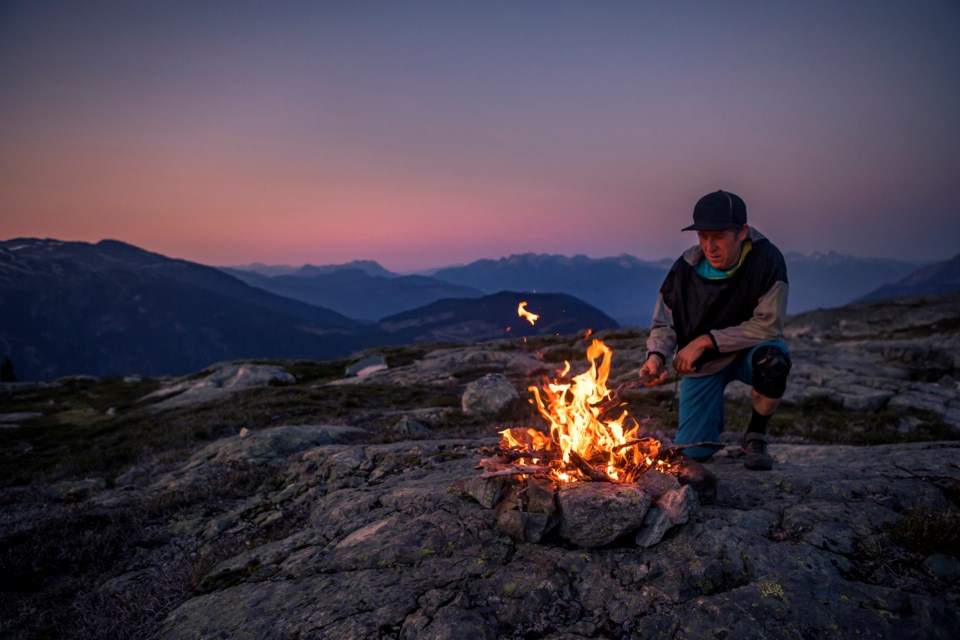Arthur De Jong has never been shy about what drove him into local politics. Now in his second term at municipal hall, the former mountain planning and environmental resource manager for Whistler Blackcomb said, “I’m a councillor because of my environmental concerns, and [the risk of wildfire] is No. 1 on that list.”
And with good reason. The common refrain you hear not just from De Jong and his fellow councillors, but from local firefighters as well, is that it’s not a matter of if a devastating wildfire hits the resort, but when.
“I think we’re very fortunate” to have avoided a major wildfire, said Whistler Fire Rescue Service Chief Thomas Doherty. “Unfortunately, it might be a matter of time, but we need to do everything we can to mitigate the risk here.”
After a tinder-dry late spring, and with the images of town-razing blazes in Fort McMurray, Lytton, and California still wedged firmly in mind, resort officials are mulling a permanent campfire ban for Whistler that would, if approved, go into effect in the summer months.
“I 100-per-cent would back that today,” said De Jong.
“Our forests are a growing, ticking timebomb — and the fuse is getting drier.”
The potential move doesn’t come without precedent. In June, the Whistler Fire Rescue Service decided to maintain a campfire ban locally even after the provincial Coastal Fire Centre lifted its fire ban for the Sea to Sky.
“Anytime we’re seeing this increased drying trend over the summer and long fire season, we have to look at all different options to mitigate the risk posed to the Whistler community. [A campfire ban] is one thing, obviously, to be considered, and we still have to have lots of discussion around that,” Doherty said. “We understand everyone enjoys sitting around a campfire with family and friends, telling stories and roasting marshmallows, but they do pose an inherent risk to the community in wildfire season.”
Part of the rationale behind a potential ban is mitigating the uncertainty that can come from toggling between different fire-danger ratings—particularly in a town that regularly welcomes visitors and newcomers.
“Through the months of June, July, August, and even September, we’re typically in high or extreme conditions, and going back and forth from a [campfire] ban being lifted to not being lifted, it creates a lot of confusion in the community,” explained Doherty. “If we look at something more standardized in the months between June and September, it takes away a lot of that confusion.”
De Jong would like to take the campfire ban a step further, when Whistler is in an extreme danger rating, by considering closing specific areas more prone to the spread of wildfire.
“I’m taking the Whistler Blackcomb model as an example,” he said. “If you’re on the Peak 2 Peak and look at the south aspect of Blackcomb, below the Rendezvous [Lodge], it is very dry forest, with steep slopes. If a fire started mid-slope, the damage it could do to the Peak 2 Peak and the public risk in the Rendezvous area is very significant.”
De Jong said more research is needed to understand Whistler’s specific “trigger zones” and the risks posed there.
“I want to study further where our highest risk points are in the valley, or either side of the valley, and should we have closures in specific areas?” he said. “It’s one thing to get into an extreme rating; it’s another thing after you’ve been in extreme three, four weeks and there are fires all over B.C. and the province’s firefighting resources are exhausted. There’s a point where you really need to buckle down in in terms of escalating risk within that extreme rating.”
Adding to the risk this fire season was the record-setting month of May, when persistent hot, dry conditions meant the region’s snowpack was at a fraction of its historical levels, melting at a quicker pace than forecasters can remember.
“It turns out May was the hottest May, at least in recorded history, for B.C., and that’s when we saw pretty dramatic melts of the snowpack,” noted Jonathan Boyd, hydrologist for the B.C. River Forecast Centre. “From a provincial perspective, it was the fastest melt of the snowpack, based on our monitoring stations, that we’ve ever seen.”
Snowpack levels have a direct connection to wildfire risk.
“When the snowpack is lower and it melts rapidly, the ground, usually covered by snow, can dry out quicker,” Boyd explained. “This was also a year where there was a lot less precipitation than normal, so the combination of the snowpack … and the speed at which it melted, with how dry it’s been at the start of summer, can elevate the risk.”
Snowpack levels for the South Coast region dipped from 98 per cent of their historical average on May 1, to 52 per cent by June 1. By June 15, the last bulletin the River Forecast Centre issued for the season, it had fallen further to just 30 per cent of normal.
“It really was quite extraordinary how rapid the snow melted,” Boyd added.
Whistler’s current fire danger rating is extreme, meaning campfires are banned.
The Resort Municipality of Whistler offers free FireSmart home assessments to help residents identify specific actions and upgrades they can take to reduce wildfire risk on their property. Learn more at whistler.ca/firesmart.




